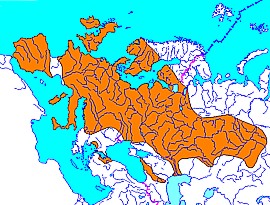|
 SCIENTIFIC
NAME : Myotis daubentonii Kuhl, 1817 SCIENTIFIC
NAME : Myotis daubentonii Kuhl, 1817
COMMON NAMES: Daubenton's bat
SYNONIMS: aedulis Jenyns, 1839 = albus Fitzinger,
1871; volgensis Eversmann, 1840; lanatus Crespon,
1844; minutellus Fitzinger, 1871; staufferi Fatio,
1890; capucinellus Fitzinger, 1971; nathalinae Tupinier,
1977.
SIZE: Body mass 6-10 g, head and body length ca. 40-60 mm, tail
length ca. 30-50 mm, forearm length 35-42 mm, wingspan ca. 24-27
cm.
DESCRIPTION: Ear of moderate length, facial mask almost naked, with
pinkish skin. Hind foot measured with claws slightly longer than
half of tibia (ca. 60%). Wing membrane attaching to metatarsus.
No calcar lobe. Fur very dense, plain and relatively long. Hairs
with dark bases. Dorsal coloration brown with various tints: from
grayish and silvery-buff to chocolate, contrasting with almost white
or pale-gray belly. Abnormaly colored individuals are known (melanistic,
albinos, piebolds). Small upper premolars well developed, usually
not extruded from the tooth row. Upper molars with well-prononced
paraconules.
DISTRIBUTION: Forested and forest-steppe zone of Europe (northward
up to the Arctic circle), Asia Minor, Caucasus and Western Siberia.
NATURAL HISTORY: Usually confined to river valleys. The most common
summer roosts are hollow trees, human buildings, crevices in rocks
and limestone. Emergence takes place in late dusk. The flight is
moderately fast, usually somewhat irregular with shifts in altitude,
occasionally moves in regular circles above water. Usualy flies
low above the water, catching small semiaquatic and aquatic insects
in the air or taking pray from water surface (a behavioral pattern
called 'trawling'). The echolocation signals are of moderate intensity,
usually within the range of 85-35 kHz, and with maximum energy around
45 kHz. In summer nursing colonies of some 15 to 100 (eventually
more) females are formed, sometimes together with other bat species.
Adult males keep separately or reside in the same roost with females.
Settled species, hibernates in caves, crevices, mines and other
underground habitats, sometimes forming large aggregations. Maiting
occurs during winter period. Time of gestation ca. 2 months, births
take places in the beginning of summer. One newborn in a litter.
Time of lactation about 6-8 weeks. Longevity up to 22 years.
STATUS: Common and abundant species with wide distribution range.
IUCN: «LR: lc»
|






